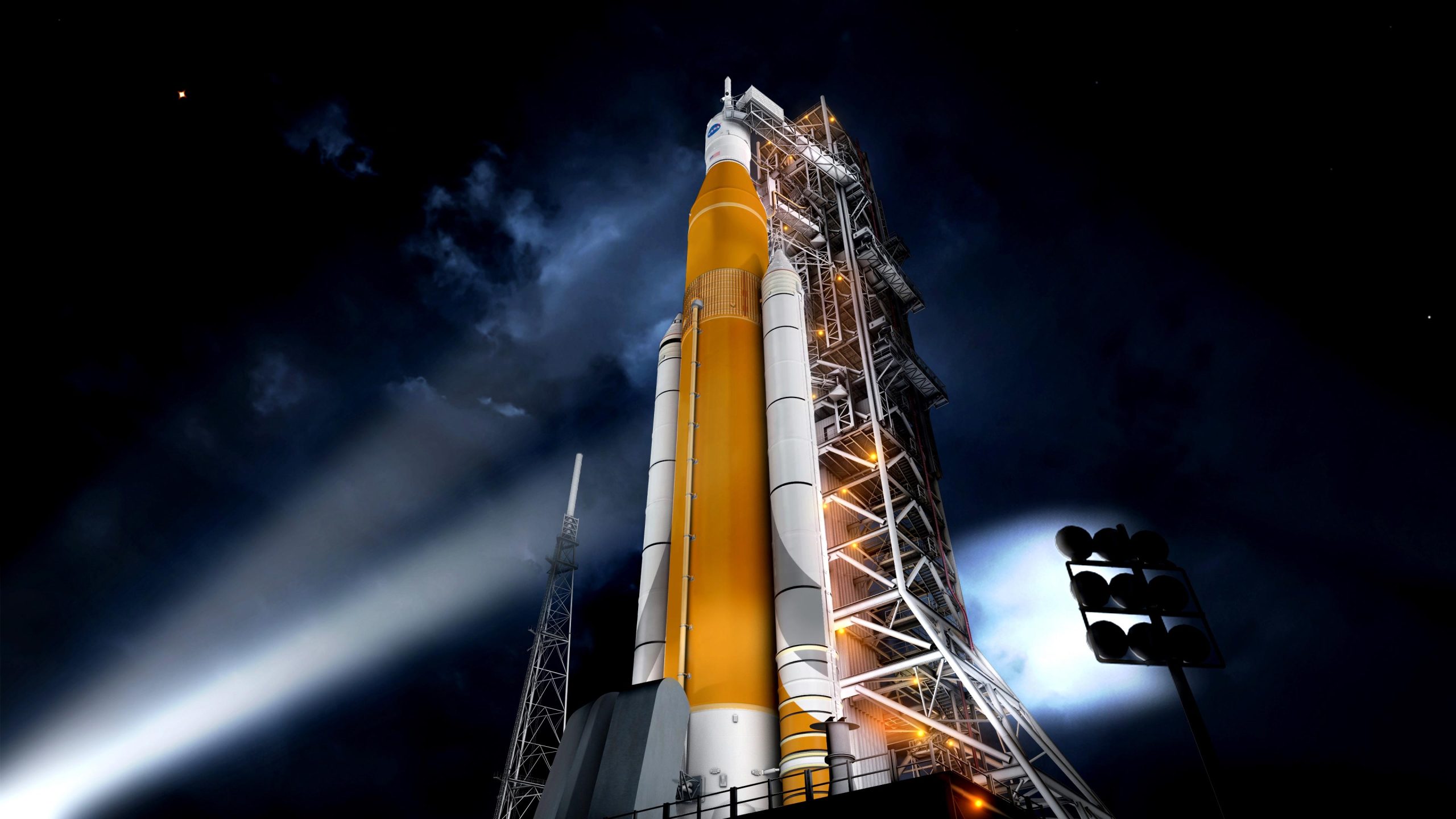
رسوم توضيحية لصاروخ نظام الإطلاق الفضائي ومركبة أوريون الفضائية على منصة الإطلاق. الائتمان: ناسا
يعطي مديرو ناسا فكرة “الانتقال” إلى Artemis I ، مع تقدم العد التنازلي
التقى مديرو Artemis I بعد ظهر يوم الاثنين لمراجعة عمليات العد التنازلي وحالة كليهما منتجات التكنولوجيا المفتوحةو “Go” للتوجه نحو الإصدار يوم الأربعاء ، 16 نوفمبر. تفتح نافذة الإطلاق التي تبلغ مدتها ساعتان في الساعة 1:04 مساءً بتوقيت شرق الولايات المتحدة.
أكمل المهندسون تحليلاً مفصلاً للخط الفاصل بين نظام إجهاض الإطلاق في Orion ودرز في مهايئ وحدة الطاقم وفحصوا المخاطر المحتملة إذا انفصلوا أثناء الإطلاق. قرر فريق إدارة المهمة أن المواد الإضافية ، في حالة تمزيقها ، من غير المرجح أن تشكل خطرًا كبيرًا على الطائرة.
https://www.youtube.com/watch؟v=lAUdIoXandI
خلاصة سريعة[{” attribute=””>NASA’s history in space exploration segueing to Artemis serves as the opening video for the launch broadcast for the agency’s Artemis I mission. The broadcast originates from Kennedy Space Center in Florida, where NASA’s Space Launch System rocket and Orion spacecraft will lift off from Launch Complex 39B no earlier than November 16 on a mission beyond the Moon and back to Earth. Credit: NASA
Technicians also completed replacing a component of an electrical connector on the hydrogen tail service mast umbilical. While swapping the component did not fully fix the issue, engineers have redundant sources of information supplied through the connector.
Listen to a replay of the Artemis I Prelaunch Mission Update media teleconference that took place on November 14.

The area where caulk on a seam between the Orion launch abort system’s ogive and crew module adapter detached during Hurricane Nicole. Credit: NASA
The countdown, which began Monday at 1:54 a.m., is progressing smoothly. All elements of the rocket and spacecraft are powered up. Overnight, teams will charge flight batteries, conduct final walkdowns at the launch pad, and check out communications with Orion.
Weather conditions remain 90% favorable for the Artemis I launch based on the Monday, November 14 forecast from meteorologists with the U.S. Space Force Space Launch Delta 45.

A close-up view of the area.where caulk on a seam between the Orion launch abort system’s ogive and crew module adapter detached during Hurricane Nicole. Credit: NASA
The following milestones remaining in the countdown are below. Live coverage of tanking operations with commentary on NASA TV will begin on Tuesday, November 15 at 3:30 p.m. Full launch coverage in English will begin at 10:30 p.m. Click here for the latest information on launch briefings and events.
L-32 hours and counting
- Core stage composite overwrapped pressure vessel (COPV) Pressurization to Flight Pressure (L-32M – L-23H)
- The ICPS is powered down (L-31H – L-30H30M)
- Charge Orion flight batteries to 100% (L-31H – L-27H)
- Charge core stage flight batteries (L-28H – L-22H)
- The ICPS is powered-up for launch (L-19H30M – L-16H30M)
L-15 hours and counting
- All non-essential personnel leave Launch Complex 39B (L-13H – L-11H)
- Ground Launch Sequencer (GLS) activation (L-11H15M – 10H15M)
- Air-to-gaseous nitrogen (GN2) changeover and vehicle cavity inerting (L-11H45M – launch)
L-10 hours, 40 minutes and counting
- 3.5-hour built in countdown hold begins (L-10H40M – L-7H10M)
- Launch team conducts a weather and tanking briefing (L-10H40M – L-9H50M)
- Launch team decides if they are “go” or “no-go” to begin tanking the rocket (L-9H40M)
- Core stage LOX transfer line chilldown (L-9H15M – L-9H)
- Core stage LH2 transfer line chilldown (L-9H15M – L-8H45M)
L-8 hours and counting
- Core stage LOX main propulsion system chilldown (L-9H – L-8H20M)
- Core stage LH2 slow fill start (L-8H45M – L-7H50M)
- Core stage LOX slow fill (L-8H20M – L-8H5M)
- Core stage LOX fast fill (L-8H5M – L-5H15M)
- Core stage LH2 fast fill (L-7H50M – L-6H10M)
- Engine bleed kick start (L-7H40M – L-7H20M)
- Core stage LH2 topping (L-6H10M – L6H5M)
- Core stage LH2 replenish (L-6H5M – launch)
- Core stage LOX topping (L-5H15M– L-5H5M)
- ICPS LH2 ground support equipment and tank chilldown (L-5H20M – L-5H)
L-5 hours and counting
- Core stage LOX replenish (L-5H5M – launch)
- ICPS LOX main propulsion system chilldown (L-5H5M– L-4H45M)
- ICPS LH2 fast fill start (L-5H5M – L4H5M)
- Orion communications system activated (RF to mission control) (L-4H20M – L-3H45M)
- ICPS LOX fast fill (L-4H55M– L-4H10M)
- ICPS LOX validation and leak test (L-4H10M – L-3H40M)
- ICPS LH2 validation and leak test (L-4H – L-3H40M)
- ICPS LH2 tank topping start (L-3H40M – L-3H25M)
- ICPS LH2 replenish (L-3H25M – launch)
- ICPS LOX topping (L-3H40M – L-3H20M)
- ICPS LOX replenish (L-3H20M – launch)
- ICPS/Space Launch System telemetry data verified with Mission Control Center and SLS Engineering Support Center (L-2H55M – L-2H45M)
- ICPS LOX validation and leak test (L-2H55M – L-2H30M)
- ICPS LH2 replenish (L-2H50M – launch)
- ICPS LOX topping (L-2H30M – L-2H10M)
- ICPS LOX replenish (L-2H10M – launch)
- ICPS/Space Launch System (SLS) telemetry data verified with Mission Control Center and SLS Engineering Support Center (L-3H – L-2H50M)
L-50 minutes and counting
- Final NASA Test Director briefing is held (L-50M)
L-40 minutes and holding
- Built in 30-minute countdown hold begins (L-40M)
L-15 minutes and holding
- The launch director polls the team to ensure they are “go” for launch
T-10 minutes and counting
- Ground Launch Sequencer (GLS) initiates terminal count (T-10M)
- GLS go for core stage tank pressurization (T-6M)
- Orion ascent pyros are armed (T-6M)
- Orion set to internal power (T-6M)
- Core stage LH2 terminate replenish (T-5M57S)
- GLS is go for flight termination system (FTS) arm (T-5M)
- GLS is go for LH2 high flow bleed check (T-4M40S)
- GLS is go for core stage auxiliary power unit (APU) start (T-4M)
- Core Stage APU starts (T-4M)
- Core stage LOX terminate replenish (T-4M)
- ICPS LOX terminate replenish (T-3M30S)
- GLS is go for purge sequence 4 (T-3M10S)
- ICPS switches to internal battery power (T-1M56S)
- Core stage switches to internal power (T-1M30S)
- ICPS enters terminal countdown mode (T-1M20S)
- ICPS LH2 terminate replenish (T-50S)
- GLS sends “go for automated launch sequencer” command (T-33S)
- Core stage flight computer to automated launching sequencer (T-30S)
- Hydrogen burn off igniters initiated (T-12S)
- GLS sends the command for core stage engine start (T-10S)
- RS-25 engines startup (T-6.36S)
T-0
- Booster ignition, umbilical separation, and liftoff

Artemis I will be the first integrated flight test of NASA’s deep space exploration system: the Orion spacecraft, Space Launch System (SLS) rocket and the ground systems at Kennedy Space Center in Cape Canaveral, Florida. The first in a series of increasingly complex missions, Artemis I will be an uncrewed flight that will provide a foundation for human deep space exploration, and demonstrate our commitment and capability to extend human existence to the Moon and beyond. Credit: NASA
https://www.youtube.com/watch؟v=nkYSTLr8LWk
خلال هذه المهمة ، سيتم إطلاق المركبة الفضائية أوريون على أقوى صاروخ في العالم وتطير أبعد من أي مركبة فضائية من صنع الإنسان. سوف يسافر 280.000 ميل من الأرض وآلاف الأميال وراء القمر في حوالي ثلاثة أسابيع. بدون الذهاب إلى محطة الفضاء ، سيبقى رواد الفضاء في الفضاء لفترة أطول من أي مركبة فضائية ، وسيعودون إلى منازلهم بشكل أسرع وأكثر سخونة من أي وقت مضى. الائتمان: ناسا

“متعصب التلفزيون. مدمن الويب. مبشر السفر. رجل أعمال متمني. مستكشف هواة. كاتب.”






More Stories
زوج من نفاثات البلازما الضخمة تندلع من ثقب أسود هائل | الثقوب السوداء
الأسمنت المستوحى من عظام الإنسان أصعب بخمس مرات من الخرسانة العادية
تدفع شركة SpaceX صاروخ Falcon 9 إلى حافة الهاوية في هبوط نادر ومميت